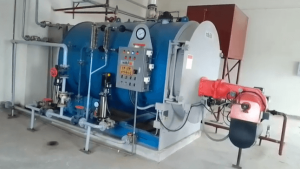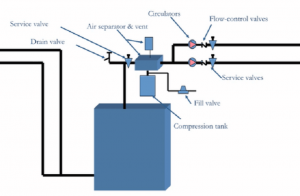Disclosure: As an Amazon Associate, I earn from qualifying purchases. Learn more
A heat pump is a mechanical device that transfers heat from one place to another. It uses a compressor and evaporator to move heat, much like a refrigerator or air conditioner. The main difference between a heat pump and these other devices is the direction of heat flow.
A refrigerator moves heat from the inside of the fridge to the outside, while an air conditioner does the reverse. A heat pump can move heat in either direction, making it an ideal choice for both heating and cooling homes and businesses.
A heat pump is a lot like a refrigeration system in that it uses coils and compressors to move heat from one place to another. The main difference is that a heat pump can move heat in either direction, while a refrigeration system can only move heat from a colder area to a hotter area.

What is the Similarity between Heat Pump And Refrigeration Systems?
There are many similarities between heat pumps and refrigeration systems, but the most important similarity is that both systems use a compressor to circulate refrigerant. Both systems also have evaporators and condensers, which are used to transfer heat. The main difference between the two systems is that a heat pump circulates refrigerant in a closed loop, while a refrigeration system circulates refrigerant in an open loop.
What Makes a Heat Pump Different from Other Refrigeration Systems?
A heat pump is a refrigeration system that uses a compressor to move heat from one location to another. The most common type of heat pump is the air-source heat pump, which transfers heat between your home and the outside air. Heat pumps can also transfer heat between the ground and your home, or between water and your home.
Heat pumps are different from other refrigeration systems because they can move heat in either direction. Most refrigeration systems can only move heat from a cool area to a warm area. But because heat pumps use a compressor, they can also move heat from a warm area to a cool area.
That’s how they can both heat and cool your home.
What Is the Difference Between a Heat Pump And a Refrigeration Cycle?
The most fundamental difference between a heat pump and a refrigeration cycle is that a heat pump moves heat from one location to another, while a refrigeration cycle simply moves heat from within an enclosed space to the outside environment. In other words, a heat pump can be used for both heating and cooling, while a refrigeration cycle is only used for cooling. The basic refrigeration cycle uses four components – compressor, condenser, evaporator, and expansion valve – in order to move heat.
The compressor compresses the refrigerant gas, which raises its temperature. The hot gas then enters the condenser where it transfers its heat to the surrounding air or water (depending on the type of system). The now cooled refrigerant gas then enters the evaporator where it absorbs heat from the surrounding air (or water), causing it to vaporize.
Finally, the expansion valve regulates the flow of gas into the compressor, starting the whole process over again. A typical home air conditioner actually uses two different kinds of cycles – one for low temperatures (the “refrigeration” part) and one for high temperatures (the “heat pump” part). At lower ambient temperatures, it is more efficient to simply move existing heat out of your home using the traditional refrigeration method described above.
However, once outside temperatures rise above about 85 degrees Fahrenheit, it becomes more efficient to actually reverse the process and transfer heat from outside into your home. This is what is known as a “heat pump” system.
Why is the Refrigerator Considered a Heat Pump?
The refrigerator is considered a heat pump because it uses a compressor to circulate refrigerant throughout the system. This refrigerant absorbs heat from the air inside the fridge and transfers it to the air outside.
Secondly, the fridge has coils or fins that help dissipate this heat. These coils are usually made of copper or aluminum and they help transfer heat away from the refrigerant and into the surrounding air. Finally, the fridge has a fan that blows air over these coils and helps circulate cool air throughout the interior of the appliance.
Relation Between Refrigerator and Heat Pump
Describe Why Variable-Speed Compressor Motors are More Efficient
As the world becomes more energy-conscious, manufacturers are looking for ways to make their products more efficient. One area that is seeing significant improvement is compressor motors. In the past, most compressors used fixed-speed motors that ran at full speed all the time.
However, newer variable-speed compressor motors are much more efficient because they can adjust their speed to match the demand. The biggest benefit of variable-speed compressor motors is that they can save a lot of energy. Fixed-speed motors run at the same speed all the time, even when the demand for air or other compressed gases is low.
This means that they are wasting a lot of energy when there is no need for high levels of compression. Variable-speed compressor motors, on the other hand, can adjust their speed to match the demand. This means that they use less energy overall and can still provide the same level of service when needed.
In addition to saving energy, variable-speed compressor motors also tend to last longer than fixed-speed models. This is because they put less stress on the motor itself since it isn’t running at full speed all the time. As a result, you may not have to replace your variable-speed compressor motor as often as you would a fixed-speed one.
If you are in need of a new air compressor or another type of gas compression system, be sure to ask about variable-speed models. You may be surprised at how much money you can save in both energy costs and maintenance over time!
What Controls the Heat Pump to Determine Whether It is in the Heating Cycle Or the Cooling Cycle?
In most cases, the heat pump is controlled by a thermostat that senses the temperature inside the building. When the temperature drops below a certain point, the thermostat signals the heat pump to switch to heating mode. In this mode, the heat pump moves heat from the outside air into the building.
Once the desired temperature is reached, the thermostat tells the heat pump to switch back into cooling mode. In cooling mode, the heat pump removes heat from inside the building and releases it outdoors.
Where is the Only Permanent Suction Line on a Heat Pump?
A heat pump is a device that transfers heat energy from one place to another. Heat pumps are used to move thermal energy in the form of hot air or water from one location to another. The most common type of heat pump is the air-source heat pump, which moves heat between your home and the outdoors.
The only permanent suction line on a heat pump is located at the outdoor compressor unit. This line sucks in warm air from the atmosphere and delivers it to the indoor unit where it can be used to warm your home. The suction line must be kept clear of debris and any other obstructions so that it can continue to function properly.
Which of the Following is Not a Typical Compressor Used in Residential Heat Pump Systems?
One of the most common questions we get here at HVAC School is about the types of compressors used in residential heat pump systems. The answer, unfortunately, is not as straightforward as it may seem. In order to understand which compressor is used in your particular system, you first need to know a little bit about how heat pumps work.
A heat pump uses a refrigerant to absorb heat from the air or ground outside and transfer it inside. The refrigerant then goes through a compressor where it is pressurized and cooled before being sent back outside to start the process over again. The type of compressor used in a heat pump can vary depending on several factors, including the climate you live in and the efficiency rating of your system.
In general, however, there are three types of compressors that are most commonly used in residential heat pump systems: scroll, reciprocating, and rotary.
Scroll compressors are typically found in higher-end systems and are known for their quiet operation and reliability. Reciprocating compressors are more common in mid-range systems and offer a good balance of performance and price.
Rotary compressors are typically found in lower-end units but can still be quite efficient if properly maintained. So which type of compressor is not typically used in residential heat pump systems? Drum roll please…the centrifugal compressor!
Centrifugal compressors are generally only found in commercial or industrial applications because they are very large and expensive. However, there are some smaller units on the market that could be suitable for a home application if you do your research!
Conclusion
A heat pump is a mechanical-compression cycle device that can be used to provide heating or cooling for a home. Unlike a typical air conditioner or refrigerator, a heat pump does not directly generate cool or hot air. Instead, it uses refrigeration principles to move heat from one place to another.
In the winter, a heat pump extracts warmth from the outdoor air and delivers it indoors. In the summer, the process is reversed, and the unit pulls heat out of your home and releases it outdoors.
Related Post:

